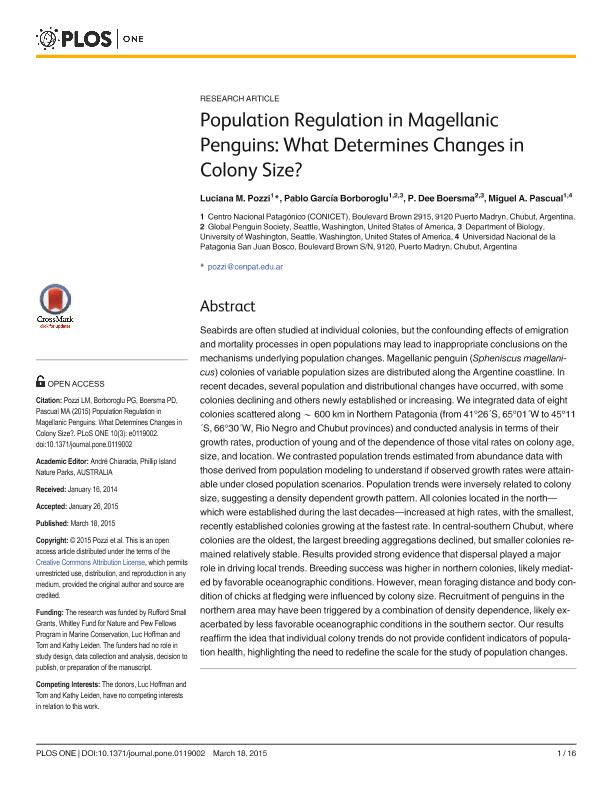Artículo
Population regulation in Magellanic penguins: what determines changes in colony size?
Fecha de publicación:
18/03/2015
Editorial:
Public Library of Science
Revista:
Plos One
e-ISSN:
1932-6203
Idioma:
Inglés
Tipo de recurso:
Artículo publicado
Clasificación temática:
Resumen
Seabirds are often studied at individual colonies, but the confounding effects of emigration and mortality processes in open populations may lead to inappropriate conclusions on the mechanisms underlying population changes. Magellanic penguin (Spheniscus magellanicus) colonies of variable population sizes are distributed along the Argentine coastline. In recent decades, several population and distributional changes have occurred, with some colonies declining and others newly established or increasing. We integrated data of eight colonies scattered along ~600 km in Northern Patagonia (from 41°26´S, 65°01´W to 45°11´S, 66°30´W, Rio Negro and Chubut provinces) and conducted analysis in terms of their growth rates, production of young and of the dependence of those vital rates on colony age, size, and location. We contrasted population trends estimated from abundance data with those derived from population modeling to understand if observed growth rates were attainable under closed population scenarios. Population trends were inversely related to colony size, suggesting a density dependent growth pattern. All colonies located in the north — which were established during the last decades — increased at high rates, with the smallest, recently established colonies growing at the fastest rate. In central-southern Chubut, where colonies are the oldest, the largest breeding aggregations declined, but smaller colonies remained relatively stable. Results provided strong evidence that dispersal played a major role in driving local trends. Breeding success was higher in northern colonies, likely mediated by favorable oceanographic conditions. However, mean foraging distance and body condition of chicks at fledging were influenced by colony size. Recruitment of penguins in the northern area may have been triggered by a combination of density dependence, likely exacerbated by less favorable oceanographic conditions in the southern sector. Our results reaffirm the idea that individual colony trends do not provide confident indicators of population health, highlighting the need to redefine the scale for the study of population changes.
Palabras clave:
Magellanic Penguin
,
Colony Size
,
Population Regulation
,
Patagonia
Archivos asociados
Licencia
Identificadores
Colecciones
Articulos(CCT-CENPAT)
Articulos de CTRO.CIENTIFICO TECNOL.CONICET - CENPAT
Articulos de CTRO.CIENTIFICO TECNOL.CONICET - CENPAT
Citación
Pozzi, Luciana Melina; Garcia Borboroglu, Jorge Pablo; Boersma, P. Dee; Pascual, Miguel Alberto; Population regulation in Magellanic penguins: what determines changes in colony size?; Public Library of Science; Plos One; 10; 3; 18-3-2015; 1-16; e0119002
Compartir
Altmétricas




